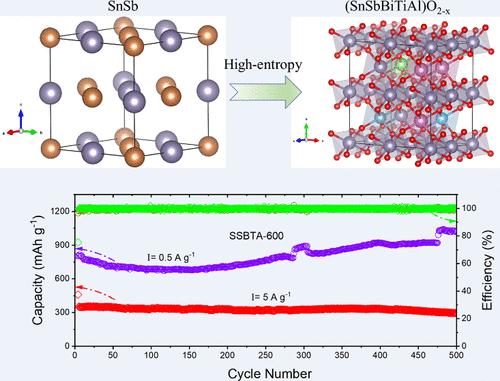snsb基阳极多价诱导稳定性的高熵工程
IF 8.2
2区 材料科学
Q1 MATERIALS SCIENCE, MULTIDISCIPLINARY
引用次数: 0
摘要
由于合金型阳极在循环过程中体积变化很大,因此实现高能量密度和长循环寿命仍然是一个重大挑战。在这里,我们引入了一种高熵工程方法,使用基于snsb的氧化物与Ti和Al共掺杂(SSBTA-600),旨在促进在600°C的煅烧温度下形成有效的氧空位。经过500次循环后,该电池在0.5 a g-1和5 a g-1下的容量分别达到1012 mAh和297 mAh,容量保持率分别达到99%和83.5%。LiFePO4||SSBTA全电池在100次循环后达到134 mAh g-1,保留率为89.4%,证明了其在锂离子电池中的实际应用潜力。电子顺磁共振(EPR)和x射线吸收光谱(XAS)证实了钛和铝的多价性导致SSBTA-600中存在大量氧空位。这种高熵工程方法显著提高了合金型阳极的循环稳定性和高速率性能,为提高合金型阳极的能量密度和循环寿命提供了一种有前途的策略。本文章由计算机程序翻译,如有差异,请以英文原文为准。

High-Entropy Engineering for Multivalency-Induced Stability in SnSb-Based Anodes
Achieving high energy density and long cycle life in alloy-type anodes remains a significant challenge due to the large volume changes during cycling. Here, we introduce a high-entropy engineering approach using SnSb-based oxides codoped with Ti and Al (SSBTA-600), designed to promote the formation of efficient oxygen vacancies at a calcination temperature of 600 °C. This approach results in remarkable performance with a capacity of 1012 mAh g–1 at 0.5 A g–1 and 297 mAh g–1 at 5 A g–1 after 500 cycles, with superior capacity retention of 99% and 83.5%, respectively. A LiFePO4||SSBTA full cell achieves 134 mAh g–1 after 100 cycles with 89.4% retention, demonstrating its practical potential for lithium-ion batteries. The high concentration of oxygen vacancies in SSBTA-600, induced by the multivalency of Ti and Al, is validated by electron paramagnetic resonance (EPR) and X-ray absorption spectroscopy (XAS). This high-entropy engineering approach significantly improves the cyclic stability and high-rate performance and provides a promising strategy for enhancing the energy density and cycle life in alloy-type anodes.
求助全文
通过发布文献求助,成功后即可免费获取论文全文。
去求助
来源期刊

ACS Applied Materials & Interfaces
工程技术-材料科学:综合
CiteScore
16.00
自引率
6.30%
发文量
4978
审稿时长
1.8 months
期刊介绍:
ACS Applied Materials & Interfaces is a leading interdisciplinary journal that brings together chemists, engineers, physicists, and biologists to explore the development and utilization of newly-discovered materials and interfacial processes for specific applications. Our journal has experienced remarkable growth since its establishment in 2009, both in terms of the number of articles published and the impact of the research showcased. We are proud to foster a truly global community, with the majority of published articles originating from outside the United States, reflecting the rapid growth of applied research worldwide.
 求助内容:
求助内容: 应助结果提醒方式:
应助结果提醒方式:


